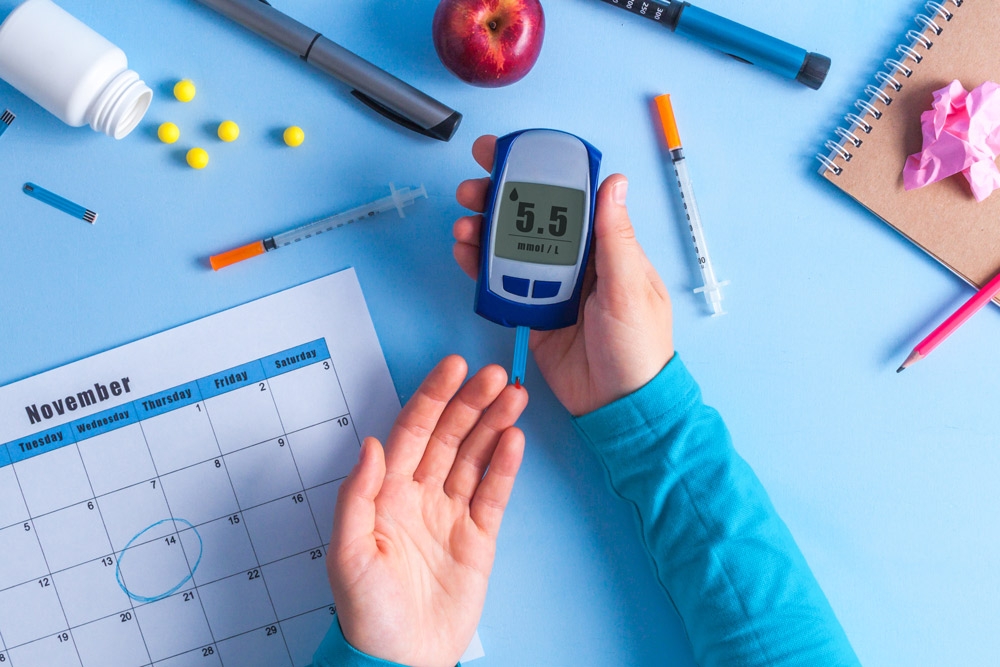Understanding Diabetes: Causes, Types, Symptoms, and Prevention
Understanding Diabetes: Causes, Types, Symptoms, and
Prevention
What is Diabetes?
Diabetes refers to a lasting condition
that affects how the body manages and controls blood glucose levels. Normally,
the hormone insulin, produced by
the pancreas, helps move glucose from the bloodstream into cells for energy. In
people with diabetes, either the body doesn’t make enough insulin or it cannot
use insulin effectively, causing glucose to build up in the blood.
According to the World Health Organization (WHO), over 540 million adults worldwide are living with diabetes as of 2023, and this number is expected to rise significantly by 2030 if current trends continue.
Causes of Diabetes
The causes of diabetes differ based on the
type, but common contributing factors include:
1.
Genetic
predisposition – A family history of diabetes increases risk.
2.
Insulin
resistance – Often seen in Type 2 diabetes, where the body’s cells
don’t respond to insulin properly.
3.
Autoimmune
reactions – In Type 1 diabetes, the immune system mistakenly attacks
insulin-producing cells.
4.
Unhealthy diet
– High intake of sugar, processed foods, and unhealthy fats can raise blood
glucose levels.
5.
Sedentary
lifestyle – Lack of regular physical activity contributes to obesity
and insulin resistance.
6. Hormonal changes – Certain conditions like polycystic ovary syndrome (PCOS) or Cushing’s syndrome may increase risk.
Causes of Diabetes Mellitus
Diabetes mellitus refers to a group of
metabolic disorders that cause high blood sugar over time. Its causes include:
·
Pancreatic
dysfunction: Damage to beta cells reduces insulin production.
·
Excess
body fat: Fat accumulation around the abdomen interferes with insulin
signaling.
·
Chronic
stress: Increases cortical, which raises blood glucose.
· Medications: Some drugs like steroids or antipsychotics can trigger diabetes symptoms.
What Are the 4 Types of Diabetes?
Diabetes is
classified into four major types,
each with distinct causes and treatment approaches:
|
Type |
Description |
|
Type 1 Diabetes |
Autoimmune
condition where the immune system destroys insulin-producing cells. Usually
diagnosed in children or young adults. |
|
Type 2 Diabetes |
The
most common type (over 90% of cases). The body becomes resistant to insulin
or produces less of it. Linked to obesity and lifestyle. |
|
Gestational Diabetes |
Occurs
during pregnancy due to hormonal changes. Usually resolves after delivery but
increases risk of Type 2 diabetes later. |
|
Prediabetes |
A
reversible condition where blood sugar is higher than normal but not yet
diabetic. Lifestyle changes can prevent progression. |
Type 1 Diabetes
Type 1 diabetes is an autoimmune disease
where the pancreas stops producing insulin. People with this condition must
take daily insulin injections or
use insulin pumps. Symptoms
usually develop rapidly in children and teenagers.
Researchers are exploring genetic and viral factors that trigger the immune system’s attack. According to the International Diabetes Federation (IDF), about 8.4 million people globally live with Type 1 diabetes.
Type 2 Diabetes
Type 2 diabetes develops gradually and
is often linked to poor lifestyle habits such as lack of exercise, obesity, and
high-sugar diets. The body either becomes resistant to insulin or does not
produce enough.
Treatment:
·
Maintaining a balanced diet (low in refined
sugar)
·
Regular exercise (at least 150 minutes weekly)
·
Medications like metformin
·
Weight management and stress reduction
Real-world data from the Centers for Disease Control and Prevention (CDC) show that Type 2 diabetes accounts for nearly 95% of all diabetes cases in adults.
What Are 10 Warning Signs of
Diabetes?
Early detection of
diabetes is crucial. Below are 10 warning
signs that may indicate high blood sugar levels:
1.
Frequent urination (polyuria)
2.
Increased thirst (polydipsia)
3.
Excessive hunger (polyphagia)
4.
Unexplained weight loss
5.
Fatigue or low energy
6.
Blurred vision
7.
Slow-healing wounds
8.
Tingling or numbness in hands and feet
9.
Frequent infections (skin, gum, or urinary)
10. Darkened
skin patches around the neck or armpits (acanthosis nigricans)
If you experience these symptoms, it’s important to get your blood sugar tested immediately.
How to Prevent Diabetes
While Type 1 diabetes
cannot currently be prevented, Type 2
diabetes prevention is highly achievable with consistent lifestyle
adjustments:
|
Prevention Tip |
Explanation |
|
Healthy diet |
Focus
on fiber-rich foods, whole grains, and green vegetables. Avoid sugary drinks
and trans fats. |
|
Physical activity |
Exercise
for at least 30 minutes a day, 5 times a week. |
|
Weight management |
Maintain
a healthy BMI between 18.5–24.9. |
|
Regular checkups |
Annual
glucose and HbA1c tests help in early detection. |
|
Quit smoking & alcohol |
These
habits raise blood sugar and insulin resistance. |
|
Stress control |
Practice
yoga, meditation, or mindfulness. |
Summary
Diabetes is a global health concern, but awareness and early action can make a life-changing difference. Understanding the causes of diabetes, recognizing the warning signs, and adopting healthy habits are essential steps toward prevention and management. With medical guidance, balanced nutrition, and regular activity, individuals can lead full, active lives despite the diagnosis.
Related Searched Keywords:
·
diabetes mellitus causes and prevention
·
type 1 and type 2 diabetes difference
·
early symptoms of diabetes in adults
·
how to prevent type 2 diabetes naturally
·
warning signs of diabetes in women
·
diabetes diet plan and lifestyle
·
causes of insulin resistance
·
diabetes treatment and management
·
pre-diabetes reversal
· global diabetes statistics 2025





